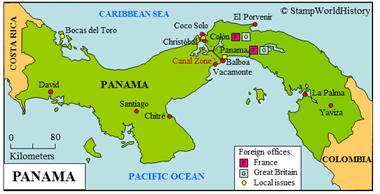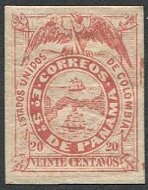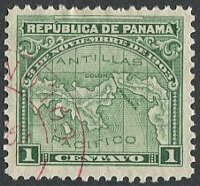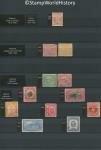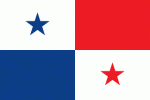
Panama
Quick reference
General issues: State Colombia 1878-1886, Department Colombia 1886-1903, Republic 1903-Present
Country name on general issues: Colombia, Panama
Special issues: Local issues Colon 1897-1899, Bocas del Toro 1903-1904, Colon 1903-1904, Panama City 1903-1904
Currency: 1 Peso = 100 Centavos 1878-1906, 1 Balboa = 100 Centimos 1906-Present
Population: 283 000 in 1903, 3 608 000 in 2014
Political history Panama
Colonization
Panama is located in Central America. Before colonization the population consisted of a range of smaller Amerindian peoples. The first Europeans to explore Panama were the Spanish in 1501. The Spanish were also the first to cross the isthmus from the Caribbean Sea to the Pacific Ocean in 1513. Panama was made a full part of the Spanish colonial empire in 1538. Panama was of strategic importance: goods were shipped from Peru to Panama, carried overland and, from the Caribbean side, shipped to Spain.
Independence from Spain
After Napoleon had invaded Spain in 1808, independence movements swept across the Spanish possessions in the Americas – Panama initially remained loyal to Spain. Panama proclaimed independence from Spain in 1821 and joined the newly formed republic of Colombia – also called Gran Colombia which included the current Colombia, Ecuador and Venezuela. In 1830, Ecuador and Venezuela broke away, and in 1831 the republic of Colombia was succeeded by the republic of New Granada, now consisting of Colombia and Panama. The republic of New Granada went through a number of political changes to ultimately, once again, become the republic of Colombia in 1886. As the political pendulum swung first to federalism and then to centralism, Panama gained the status of a sovereign state in 1855 to become a department of Colombia again in 1886.
Independence from Colombia
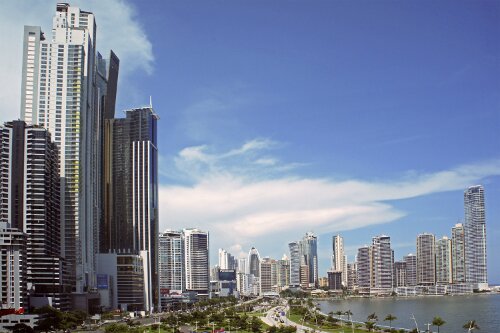
Panama City is the political and commercial capital of Panama. The metropolitan area houses 1.5 million of the 3.6 million people in the country.
Panama would remain a department of Colombia throughout the 19th century, although secessionist movements manifested themselves several times. Panama had even proclaimed independence in 1840 to join Colombia again three months later in 1841. Independence was declared again in 1903 as the republic of Panama. The independence movement was, this time, heavily supported by the United States. Panamanian independence was formally accepted by Colombia in 1921.
The interest of the United States in supporting an independent Panama was that it would be allowed to build the Panama Canal – which Colombia had not allowed the United States to do. In 1903, Panama and the United States signed the Hay-Bunau-Varilla treaty that allowed the United States to build the Canal. The sovereignty over a zone of 8 kilometers to each side of the Canal was ceded to the United States. The United States also acquired the right to intervene – by military force if need be – in Panamanian internal affairs, if the continuity of the Canal required it. Furthermore, the United States guaranteed the newly gained independence of Panama. Panama thus became a de facto United States protectorate.
The border of independent Panama with Colombia was settled as per the border of the department of Panama. The border with Costa Rica has long been disputed. The de facto border as established in 1825 was ratified as the de jure border in 1941.
Independent Panama
Panama was ruled as a constitutional democracy, power being in the hands of a small elite. From 1903 until 1968, Panama would know little political stability. In the early years the United States intervened by military force a number of times. Presidents would gain and loose power in often less than democratic ways, few serving a full term in office. In 1968, a military coup ended civilian rule. In 1969, Omar Torrijos came to power and would rule Panama until 1981. The military, on the one hand, gained popularity by introducing a number of social reforms, on the other hand, democratic rights and institutions were curtailed. In 1983, Manuel Noriega came to power. Noriega built a parallel economy of drug trafficking and money laundering. Relations with the United States – who had initially supported the military regime – deteriorated. In 1988, Noriega was convicted by United States courts of law. In 1989, the United States once more intervened in Panama by military force. Noriega was arrested and detained in the United States. In Panama democracy was restored and since 1989 Panama has been governed by democratically elected presidents.
The Panama Canal
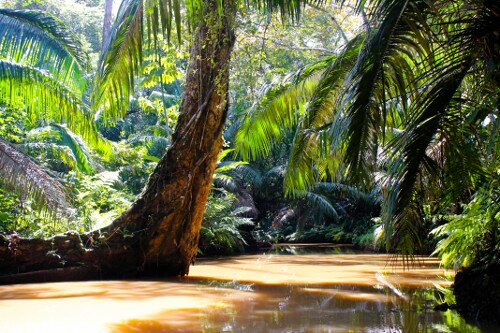
By contrast a large part of Panama is covered by jungle. A jungle that is home to the greatest diversity of species in the Americas.
Following the 1903 treaty, the Panama Canal was built between 1904 and 1914. The Hay-Bunau-Varilla treaty was, however, soon criticized for the extensive rights it granted to the United States. In a subsequent treaty signed in 1936 – ratified in 1939 – these rights were limited to the sovereignty over the Canal Zone – ending the status of Panama as a de facto protectorate. In 1977, a final settlement was agreed upon when the Carter-Torrijos treaty was signed. In a number of steps, the sovereignty over the Canal Zone would be transferred from the United States to Panama. The Panama Canal was fully transferred to Panama in 1999. In 2007, a project was started to more than double the capacity of the Canal, a project that should be completed in 2016.
Economy and demographics
The Panama economy – which in the 19th century was based on agriculture – has developed into a services economy, the services sector accounting for 75% of the GDP. The largest population group are the mestizo – people of mixed Amerindian and white origin – who account for 65% of the population. The indigenous Amerindian peoples account for 12% of the population. The other population groups are blacks, whites and mulattos – people of mixed black and white origin.
Postal history Panama
Panama as a state/department of Colombia
The first stamps used in Panama are the stamps of Colombia in 1859. The first stamps issued by Panama are issued as the state of Panama within the United States of Colombia in 1878. The stamps are inscribed ‘Estados Unidos de Colombia/E.S. de Panama'[1]‘E.S’ is short for ‘Estado Soberano’ or ‘Sovereign State’. . From 1887 until 1903, stamps are issued as the department of Panama within the Republic of Colombia. The postage stamps are inscribed ‘Colombia’ and show the map of Panama. The stamps issued by Panama, from 1878 until 1903, were valid for use within the state/department only and were used concurrently with the issues of the federal authorities of Colombia.
British offices operated in Colon from 1870 to 1881 and in Panama City from 1865 until 1884, using the general issues of Great Britain. French offices operated in Colon from 1865 until 1881 and in Panama City from 1872 until 1874, using the general issues of France. These offices would have handled foreign mail until Colombia joined the UPU in 1881.
Local issues appear in Colon from 1897 until 1899: registration stamps and acknowledgement of receipt stamps.
Independent Panama
After the declaration of independence in 1903, the first stamps issued were provisionals – overprints on both stamps of Colombia and of the department of Panama. They were issued in the cities of Bocas del Toro, Colon and Panama and exist with 8 different overprints. The first nationwide stamps were also provisionals – 3 different overprints now only on stamps of the department of Panama. The overprints exist in many varieties – inverted, double, shifted – and thus are a field for specialists. The first regular issue dates from 1905, when two stamps to commemorate independence were issued. The first definitives date from 1906. Until the 1960’s, Panama has issued stamps mainly with themes of national interest. From 1963 until 1969, stamps were issued aimed at the thematic collectors market. Since 1970, Panama reverted to a mix of themes of national interest and themes aimed at the thematic collector.
The Canal Zone, from 1904, used stamps issued specifically for the Canal Zone by the United States. As part of the step by step transfer to Panama, the stamps of Panama were used from 1979.
Album pages
← Previous page: Nicaragua - Mosquito ProvisionalsNext page: Panama - Canal Zone →

